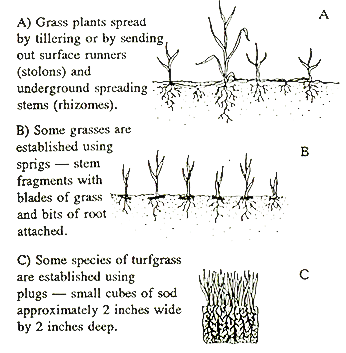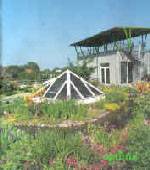 Introduction
Introduction
 When to Plant
When to Plant
 Soil Preparation
Soil Preparation
 Soil Tillage and
Grading
Soil Tillage and
Grading
 Planting,Sodding,
and Seeding
Planting,Sodding,
and Seeding
 Caring for a New
Lawn
Caring for a New
Lawn
Producing quality lawns in Virginia can be challenging.
Geographically, Virginia is located in what is known as the transition zone for
turfgrasses. This means the climate can be hostile to both cool-season grasses
(Kentucky bluegrass, tall fescue) and warm-season grasses (bermudagrass,
zoysiagrass). However, with proper cultural practices, a healthy lawn can be
established and maintained.
Turf may be established from seed, sprigs, plugs, or sod. The method depends
on the grass species desired, the environmental conditions, time constraints,
and financial considerations. If possible, use only certified seed and sod. The
same requirements for soil preparation apply for all methods.
Methods of Lawn Establishment
|
Grass |
Seed |
Sod |
Sprigs |
Plugs |
|
Kentucky bluegrass |
Yes |
Yes |
No |
No |
|
Tall fescue |
Yes |
Yes |
No |
No |
|
*Bermudagrass |
Yes |
Yes |
Yes |
Yes |
|
*Zoysiagrass |
Yes |
Yes |
Yes |
Yes |
|
Perennial ryegrass |
Yes |
No |
No |
No |
*some varieties can only be established vegetatively, not by seed
Return to Table of Contents
Turfgrasses are best established during certain periods of the year when
temperature, moisture, and day-length are most favorable for establishing
cool-season or warm-season grasses. Cool-season turfgrasses are best seeded in
late summer; early spring seedings are prone to damage from crabgrass invasions
and summer drought. Warm-season turfgrasses are best established from May to
July.
Sod of Kentucky bluegrass and tall fescue can be installed throughout the
year except in mid-winter when the ground is frozen. Sod should not be placed in
extreme heat or drought conditions.
When to plant cool-season grasses
|
Area of Virginia |
Seed |
Sod |
|
Northern Piedmont and areas in and west of the Blue Ridge |
Aug. 15 to Sept. 15 or March to early April |
Anytime
soil is not frozen |
|
Southern Piedmont and Eastern Virginia |
Sept. 1 to Oct. 15 or Feb. and March |
Anytime soil is not frozen |
When to plant warm-season grasses
|
Area of Virginia |
Seed |
Sod |
Sprigs |
Plugs |
|
*Northern Piedmont, areas in and west the Blue Ridge |
Not recommended for this area |
June 1 to July 15 |
June 1 to July 15 |
June 1 to July 15 |
|
Southern Piedmont and Eastern Virginia |
a) Hulled bermudagrass: May to July 15 b) Unhulled bermudagrass: Late
fall or winter prior to growing season |
Late May to Aug. 15 |
Late May to July 15 |
Late May to July 15 |
*select cold hardy varieties
Return to Table of Contents
Soil Test. The first step is to have the soil tested; this will
determine which nutrients are available in the soil, and will provide liming and
fertilization recommendations. Forms and instructions for obtaining soil samples
are available from your local Extension office.
Weed Control. Any perennial broadleaf or grassy weeds should be
eliminated prior to planting by properly applying a herbicide.
Installation of Irrigation and Drainage. An irrigation system or
drainage tile, if needed, should be installed prior to topsoil preparation, in
order to avoid subsoil contamination of topsoil.
Return to Table of Contents
Completely till the soil to a depth of 4 to 6 inches where:
1) soil compaction is severe; 2) large amounts of phosphorus or lime are
recommended; 3) surface drainage is inadequate; or 4) the soil is to be amended.
If the area is to be graded, first save the topsoil by moving it to one side,
stockpiling it for later use.
The subgrade should slope away from buildings, and the area should be allowed
to settle through two or more rains before planting. Low spots in the yard where
water collects should be filled with additional soil. All building debris, large
rock, and rotting wood should be removed from the site. If the topsoil has been
stockpiled, it should be spread uniformly over the entire lawn area. Ideally,
there should be a minimum of 6 to 8 inches of topsoil. Where topsoil is limited,
mix the available topsoil into the upper inch of subsoil by tilling. Once the
soil is prepared, care should be taken not to disturb it.
Lime. Turfgrasses do not perform well in acidic soils, and most soils
in Virginia are acidic - below pH 6.2, the ideal pH for lawns. Lime
recommendations to raise the soil pH to 6.2 will be made from the soil test. The
lime should be tilled into the soil to a depth of 4 to 6 inches. If soil tests
indicate low available magnesium levels, dolomitic limestone should be used.
Fertilizer. When applying the fertilizer recommended in the soil test,
it is beneficial to till in two thirds of the amount to a depth of 4 to 6
inches. The remaining one third should be applied to the surface just prior to
seeding, then lightly raked into the soil.
Return to Table of Contents
Plugging and Sprigging. Zoysiagrass and bermudagrass can be
vegetatively established, using either plugs or sprigs. The plugs should be
fitted tightly into pre-cut holes on 6 to 12 inch centers and tamped into place.
Sprigs can be broadcast and lightly disced or pressed into shallow rows on 6 to
12 inch centers and covered with soil. Sprigging rates for bermudagrass and
zoysiagrass range from 7 to 10 bushels per 1000 square feet.
Sodding. Soil preparation is similar to that described for seeding; a
smooth, firm surface is needed. On hot days, moisten the soil to cool it before
laying sod. Premium quality, certified sod is easier to transport and install
than inferior grades. Good sod is light; does not tear easily; and quickly puts
a root system into prepared, well-watered soil. Install sod as soon as you get
it; it is perishable and should not remain in a stack longer than 36 hours.
Establish a straight line lengthwise through the lawn area; lay the sod on
either side of the line with the ends staggered as when laying bricks. A sharp
masonry trowel is very handy for cutting, forcing the sod tight, and leveling
small depressions. Roll and water the new lawn immediately; irrigate to moisten
the soil below the sod until it is well-rooted into the soil.
Seed versus Sod. Successful, weed-free establishment is more difficult
with seed than with sod. Also, because of the time required for germination and
root growth of seed, the area is exposed to erosion. Sodding practically
eliminates such problems, an especially important factor on steep slopes.
Seeding and Mulching. Prepare a smooth, firm seedbed. Rake the seedbed
to create shallow, uniform depressions (rows) about a quarter-inch deep and 1 to
2 inches apart. Divide seed in half; sow first half of seed in one direction
(north/south); sow the remaining seed in the opposite direction (east/west).
Cover the seed by raking lightly. Next, the seedbed should be rolled. Mulch the
area with straw or other suitable material so that approximately 50 to 75
percent of the soil surface is covered. This is normally accomplished by
spreading 11/2 to 2 bales of high quality, weed-free straw per 1000 square feet.
A light mulch does not need to be removed after establishment of the turfgrass.
Seeding Rates
|
Turfgrass Species |
Seeding Rate lbs/1000 sq. ft. |
|
Kentucky bluegrass |
2 to 3 |
|
Tall fescue |
4 to 6 |
|
Fine fescue |
3 to 5 |
|
Perennial ryegrass |
3 to 5 |
|
Bermudagrass (hulled) |
1 t0 11/2 |
|
Bermudagrass (unhulled) |
5 to 10 |
Return to Table of Contents
Post-Planting Irrigation. New seedings and spriggings require frequent
watering to ensure constant surface moisture for 30 days following planting. On
hot days, several light waterings may be required during the day. Sod and plugs
also need constant moisture until rooted.
New Lawn Maintenance. Begin mowing the new lawn when the grass is
one-third taller than the intended mowing height. Be sure the mower blade is
sharp. Avoid excessive traffic on a lawn until it is mature. Weed control may be
necessary, but do not apply herbicides to new lawns until they have been mowed
twice. Ask your local Extension agent or nursery expert for recommendations on a
fertilization program.
It usually takes two full growing seasons for a lawn to become fully
established and exhibit the desirable characteristics for the individual turf
species, such as drought tolerance, wear tolerance, density, and competition
against weeds. Following a sound maintenance program will help your lawn mature
and persist.

Return to Table of Contents
![]() Gardeners' Corner
Kids'
Garden
Sustainable Garden
Contact Us
Gardeners' Corner
Kids'
Garden
Sustainable Garden
Contact Us![]()



